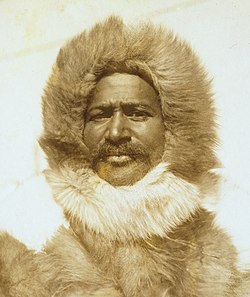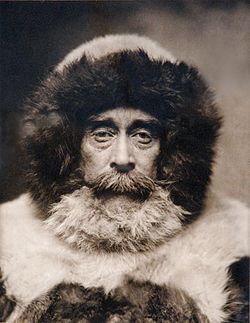Fame and honor
| Movie | |
|---|---|
| German title | Fame and honor |
| Original title | Glory & Honor |
| Country of production | United States |
| original language | English |
| Publishing year | 1998 |
| length | 94 minutes |
| Rod | |
| Director | Kevin Hooks |
| script |
Robert Caputo Jeffrey Lewis Susan Rhinehart |
| production |
Ralph Berge Lynn Raynor |
| music | Bruce Broughton |
| camera | Douglas Milsome |
| cut | Karen I. Star |
| occupation | |
| |
Fame and Honor ( English Glory & Honor ) is an American biographical film directed by Kevin Hooks from 1998. This film is based on real events. It takes place at the turn of the nineteenth and twentieth centuries and tells the story of Robert Edwin Peary and Matthew Henson's expeditions to the North Pole. On her journey through Greenland and Ellesmere Island she accompanies a group of the local Inuit .
action
First expedition: Greenland
The first trip to the Arctic began on June 12, 1891 . On board the ship are: Robert Edwin Peary , his wife Josephine , his assistant Matthew Henson and other members of the expedition. The aim of the expedition is not to reach the North Pole at any cost , but to find out whether Greenland is an island and can be used as a bridge to the North Pole. During the expedition, Peary breaks his leg, which endangers the further course of the expedition. Then he asks about his wife, who is expecting a baby. After a while they reach the north-west coast of Greenland, where they set up a base. Here they are warmly welcomed by Iqwah and the other Inuit . Henson in particular is very sympathetic to the Inuit, as his dark skin makes him look like them. Iqwah thinks he recognizes Henson as his kidnapped cousin in childhood. The Inuit provide warm fur clothing to the participants of the expedition and teach Henson how to drive a dog sled. You gave him the first name Maripaluk. But Peary despises the Inuit and their language.
In March, Peary, Henson and the team head north. Henson runs the dog sled. Peary's wife stays at the base. John Verhoeff - another member of the expedition - dies in a hole in the ice sheet . During the cold nights Peary freezes in the tent, while Henson copes much better with the cold with the warm clothes of the Inuit. He realizes that it would be better to sleep in the igloo than in the tents. Peary decides to go on the next expedition with the Inuit. Henson loses a glove while trying to save John Verhoeff. Because of the loss, he suffers frostbite on his hand; in order not to hinder the further expedition, he has to return to the base. There he received another gift from the Inuit: trousers made from the skin of a polar bear . While at the base, Henson deepened his friendship with Iqwah and his fellow human beings. On July 4, 1892, Commander Peary and his crew reached a cliff that Peary named Navy Cliff . Peary gives the name of Independence Fjord to a nearby bay . Josephine gives birth to a daughter to Peary.
Return to the USA
After returning to the USA , Peary presented the results of the expedition in a public speech. Henson appears in the room with the sled dogs and in Inuit clothes and impresses the audience. Henson later asks Peary to take part in the next expedition. Peary agrees. While the preparations for the next expedition are still in progress, the Norwegians reach the Independence Fjord from the east, proving that Greenland is an island. Henson is persuaded to start the next expedition on Ellesmere Island and to build Fort Conger as a base . Peary receives permission for the next trip from Morris Jesup .
Second expedition: Ellesmere Island
When they get approval, Robert Peary, Matthew Henson and other members of the expedition start another trip. Before winter they will reach Ellesmere Island . According to earlier assumptions, they want to come to Fort Conger in the spring. When they reach the island, an Inuk named Ootah, along with a group of other Inuit , brings word that a ship with a Norwegian expedition is nearby. Peary, fearing that the Norwegians will be the first to reach the North Pole, does not wait on board the ship until spring - all participants of the expedition and the Inuit immediately begin a 250-mile journey to Fort Conger. Unfortunately, Peary has lost eight of his toes to frostbite, and after 47 days of walking they all return to the ship. In late June, Peary's wife, Josephine, came to discover his betrayal with an Inuit woman named Aleqasina. Josephine tells him that the second daughter died at the age of eight months. It all leads to a breakup.
After these events, the participants in the expedition set out from Ellesmere Island, onto the ice of the frozen Arctic Ocean . In the spring, Matthew Henson hid food supplies in the ice for the expedition returning from the North Pole and marked them with flags. However, the supplies can no longer be found. The situation worsens when the Inuit turn back because of their beliefs and leave the expedition. The lack of food forces the participants of the expedition to abandon the journey 200 miles from the destination. To survive, they must eat dog meat on the way back.
Second return trip to the USA
Robert Peary persuades the Inuit to give him a meteorite . This is made of metal and will be sold to finance the next trip. He convinced four of the Inuit to travel to the United States with him. Six months after arriving in the United States, all four died of pneumonia . The bodies of two of them, Ahnalkah and Iqwah, are on display in a museum. It was then that Henson met Lucy Ross and her other African American relatives or friends, who argued with him about the meaning of such events, about the meaning of providing funding for this purpose and of having someone from their communities take part in this endeavor while “in Harlem a Poverty prevails ”. Some time later, Henson is married to his girlfriend Lucy Ross.
Third expedition: North Pole
Six months after Henson's wedding, Henson and Peary set out on their next voyage north aboard the new ship Roosevelt . Peary tries a new approach: During the expedition, part of the crew is to remain on the route with food for the parts of the expedition that return later. Only two groups are supposed to reach the North Pole: The Pearys and the strongest. The rest should be left behind in the camps. Peary is 52 years old at this point.
On March 1, 1909, both the crew and the Inuit left Cape Columbia at temperatures of −17 ° C. In a camp 30 miles from the North Pole, Henson overhears a conversation between Peary and Bartlett, another member of the expedition. Peary informs him that not he, but only Henson should accompany him on the rest of the route. He justifies this with the greater experience of Matthew Henson. But as an additional argument, contradicting the last statement, Peary explains that due to lack of character, which is a matter of race , Henson could not lead people back to the ship. However, later said to Henson that the next morning Peary is traveling with his group. But Henson is supposed to start March an hour later. Suddenly, Henson is secretly walking with Inuk Ootah without warning, but voluntarily stops walking for about two hours in front of the alleged North Pole. When they meet, Henson explains that he could reach the North Pole on his own, but he wanted to wait for him to share the victory with him, even though Peary didn't want to share the victory with Henson. Finally they go to the North Pole with a group of Inuit.
Final information
- Peary's opponents denied that he was the first to reach the North Pole.
- Admiral Robert Peary died in 1920 at the age of 64.
- Henson died at the age of 82.
- On April 6, 1988 Matthew Henson's ashes to the National Cemetery in the district of Arlington are transferred and buried next to the grave of Robert Peary.
Web links
- Fame and honor , OFDb ; Retrieved September 16, 2013
- Fame and honor , two thousand and one ; Retrieved September 16, 2013
- Ruhm und Ehre / Glory & Honor (1998) , MovieJones.de; Retrieved September 15, 2013
Individual evidence
- ↑ a b glory in the Internet Movie Database (English)
- ↑ a b This article describes the events depicted in the biography which was broadcast on September 18, 2009 on the Polish TV station TVN 7 . Some of the information contained therein may not fully reflect the true facts or even distort the facts (see also the individual references).
- ^ Marie Ahnighito Peary, b. on September 12, 1893 north-east of Greenland. The local Inuit called her a "snow child" because they had never seen a white baby. This is not mentioned in the film (see also individual references: Une.edu).
- ^ Marie Ahnighito Peary Papers, 1893-1978 . Une.edu (English) accessed on April 6, 2016
- ↑ The film does not explain whether one of the mummies, whether z. B. are wax figures. They are in the upright position anyway. They are dressed in typical Inuit winter clothes and they hold a spear in their hand. In 1897, six Inuit came to the United States with Peary. Four of them: Qisuk, 12-year-old Aviaq, Nuqtak and his wife Atangana, soon died in the USA. One, Uisaakassak, has gone back to Greenland. Sixth, Minik Wallace (son of Qisuk) , about 7 years old , was accepted by the curator of the American Museum of Natural History, William Wallace. His biography is featured in the documentary Minik, the Lost Eskimo .
- ↑ According to The New York Times, the ship sailed from New York on July 6, 1908 (see also individual records: NYT).
- ^ A b Commander Peary's Preliminary Account of His Successful Voyage to The North Pole . In: NYTimes.com , March 9, 1909. Retrieved September 15, 2013
- ^ Arctic Explorer Robert E. Peary. AmericasLibrary.gov.Retrieved September 15, 2013
- ↑ Robert Peary US-History.com (English) Retrieved on September 15, 2013
- ↑ According to the official sources, it reached the alleged North Pole on April 6, 1909 (see also individual records: AmericasLibrary.gov and US-History.com).



